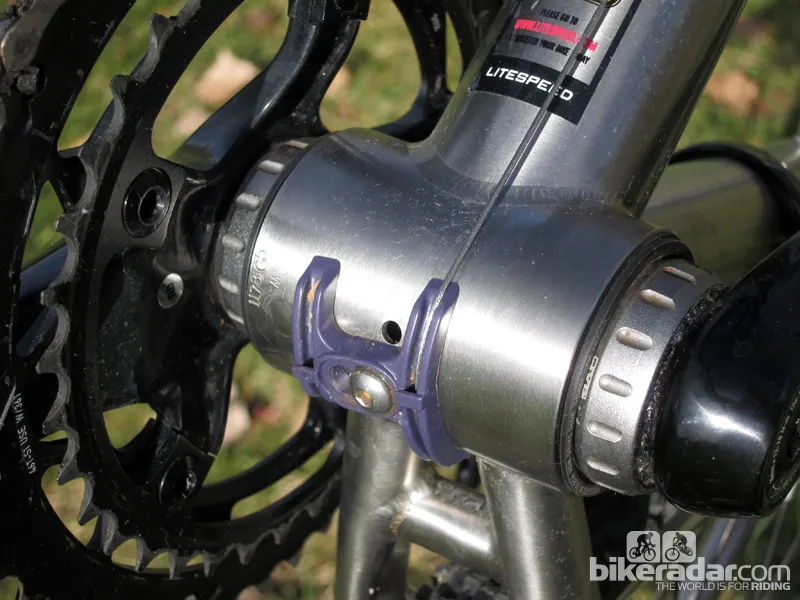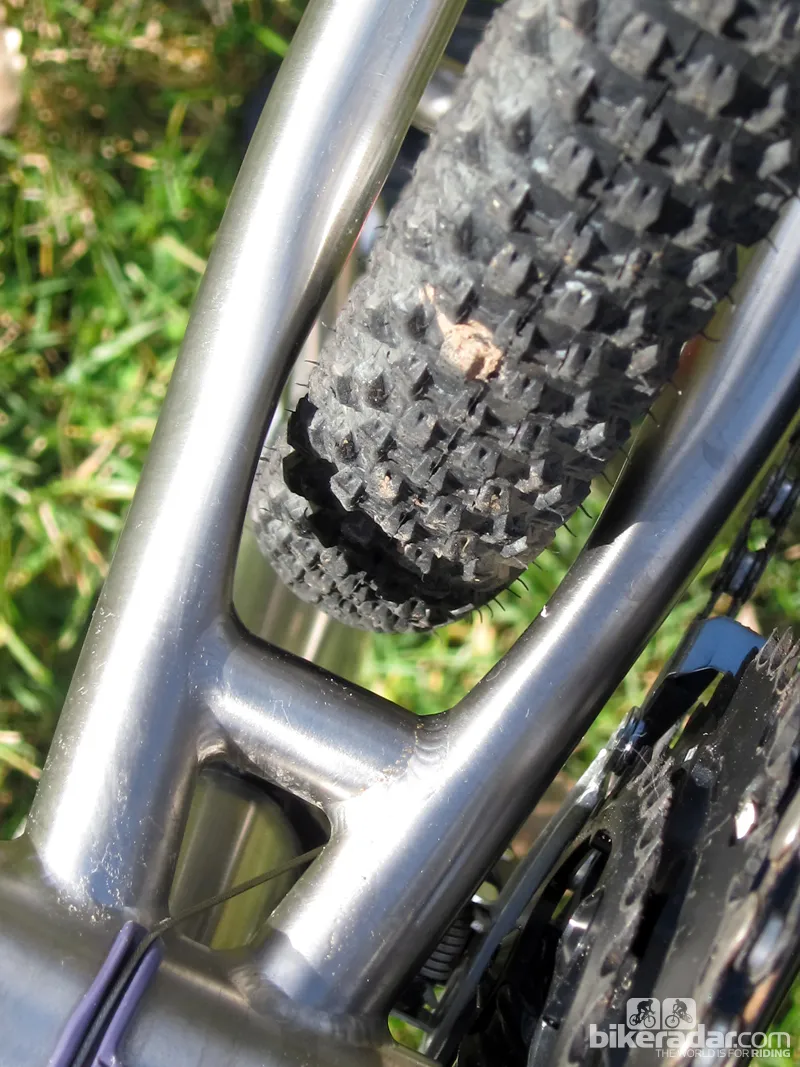Like many companies this season, Litespeed has fully committed to disc brakes for cyclocross, with the new disc-only CX. It's solid underfoot, with a fantastic ride quality and brilliant handling, proving once again that carbon fiber isn't necessarily the be-all-end-all when it comes to high-performance machines.
Top-end racers might still find it a little heavy for serious competition, and the CX is also lacking in some of the more advanced shaping afforded by composite construction. But everyday riders and privateers will still revel in the bombproof titanium frame's durability, impact resistance, and idiot-proof finish.
Ride & handling: Solid yet smooth, stable yet quick
As is often the case with titanium frames, the CX's ride quality is difficult to describe. On one hand, it's reassuringly solid and surefooted in a way that many ultralight chassis can't match – simply put, it just feels substantial. The CX practically urges you to charge forward and slam aggressively through with little worry that something in the frame will crack or buckle, especially on rough and choppy terrain.
"For this frame, I wanted comfort, raceworthy stiffness and high durability," said Brad DeVaney of American Bicycle Group (Litespeed's parent company). "I’ve designed superlight, ultraformed and highly butted 'cross frames in the past that I felt were good for two to three seasons of hard racing and training. They were essentially race-only frames with little utility otherwise. This frame is far more functional, durable, and costs approximately US$1,000 less."
On the other hand, the CX is also admirably smooth and lively – not so much in a highly damped way, as with carbon fiber, but more like a very short-travel spring with lots of pop that sucks up chatter while providing a lot of feedback from the tire patches.

Handling is surprisingly versatile and adaptable, with a mix of a tall, 6cm bottom bracket drop, a steepish 72-degree head tube angle, a long reach, and a short stem.
We'd normally expect such a high bottom bracket (which is great for navigating deep mud) to feel a little tippy through twisty corners but it's largely offset by the steep front end, which helps to quickly point the front end toward the apex of a corner. Toss in the long front center and short stem and what you get is a geometry that's stable when sliding through a fast, slippery corner but quick and nimble in slower situations.
Front-end rigidity is very good, owing to the large-diameter down tube and seat tube plus the 44mm-diameter head tube surrounding the ultra-stout 3T Luteus tapered carbon fiber fork.
However, Litespeed uses the same diameter tubing for both the chain stays and seat stays, so while the CX is smooth over the rough stuff it's not as snappy under power as some higher-end carbon bikes we've tested.
Frame: Beautiful craftsmanship but rather heavy, and the press-fit cups are problematic
Buyers who are typically drawn to a bare titanium frame's stark aesthetic will find a lot to like in the CX, with its characteristically impeccable TIG welds, enormously practical brushed finish, and sparse black-and-white decaling. While the seat stays and chain stays are elaborately bent, the frame otherwise sticks to a fairly traditional layout, with round tubing throughout.
Litespeed infuses the CX with a number of more modern touches, though, including the 44mm-diameter head tube (which can be used with either straight or tapered forks depending on which headset you choose), press-fit 30 bottom bracket shell, and 135mm rear hub spacing with TIG-welded titanium rear disc caliper posts (sized for a 160mm rotor). There's also a burly reinforcing strut between the non-driveside stays.
However, though the frame is beautiful to look at, we found several flies in the ointment.
The biggest sticking point was the press-fit 30 bottom bracket shell. We haven't had too many issues with PF30 bottom brackets on other test bikes but we were unable to keep the bearing cups in place on this one – at least with the composite SRAM cups Litespeed supplied with our bike.

Litespeed uses a PF30 bottom bracket shell on the CX
Even after carefully pulling, cleaning, and reinstalling them, just a single ride found both sides backing out slightly. They won't fall out completely but it's a sore disappointment. Switching to a different bottom bracket with less compressible metal cups will likely help. DeVaney also advocates using a material-specific retaining compound such as Loctite 380/480 for nylon cups or Loctite 609/641 for aluminum ones.
In addition, the PF30 may be huge in diameter but it's still just 68mm wide. As such, the chain stays aren't very widely separated and mud clearance down below suffers accordingly. Even with 32mm tires installed, there are just a few millimeters of room on either side of the tread.
Litespeed uses a traditional 'two up, one down' cable routing setup with just the front derailleur cable run beneath the down tube to work with a standard road front derailleur without needing a seat tube-mounted pulley.
It's cleanly done throughout and the rear brake line is designed for full housing (thus making it hydraulic-ready) but we'd like to see a third anchor in the middle of the top tube, to keep the housing from flopping about, and perhaps a continuous piece of housing from the top tube to the rear derailleur for better shift performance in wet and muddy conditions.
The round tubing is refreshingly traditional in appearance but we'd still prefer to see the underside of the top tube flattened a bit to ease the pain of shouldering. As it is, the stout titanium tubing digs into your shoulder noticeably more than a flatter and thinner-walled carbon pipe.
Finally, the Litespeed CX is disappointingly heavy for a frame that costs US$2,500. The actual weight of our medium-sized tester was 1.71kg (3.77lb) with rear derailleur hanger, seatpost collar, and water bottle bolts – almost 700g (1.5lb) heavier than a top-end carbon frame.
Equipment: Solid workhorse kit for us but buyers can DIY to taste
Litespeed sells the CX as a bare frame only, meaning that buyers will have to put a little more thought into what they choose. But at least you won't be stuck with any stock items you might not want.
Our test bike was part of Litespeed's demo fleet and came equipped with a collection of workhorse gear, including a SRAM Rival group, Avid BB7 mechanical disc brakes, Stan's NoTubes Alpha 340 Disc tubeless-compatible clincher wheels, Kenda Small Block Eight tires, and a Palladio Team carbon fiber seatpost.
We also got an ARX Team forged aluminum stem, Ergoterra Team carbon fiber handlebar, and Luteus carbon fiber tapered disc fork, all from 3T. Total weight as supplied was 8.61kg (19.0lb).
On the whole, we found few surprises with the mostly familiar build kit. SRAM's Rival group continues to be one of our favorites for privateer 'cross racing, owing to its Red-like shift performance, feel, ergonomics, and weight. Plus, its bargain pricing eases the sting of nasty equipment-crunching wrecks.
Likewise, the 3T gear was tough to fault. The Luteus disc fork is one of our favorites for its stout construction and plentiful mud clearance. The lightweight Ergoterra Team's flared bend offers up an impressive amount of wrist clearance in the drops. And while frustrating to set up initially, the Palladio Team's uniquely serrated seatpost head is utterly impervious to slipping during a remount.

We like the outward flare on the 3T Ergoterra 'cross-specific handlebar
As we've noted on several occasions, the Avid BB7 disc brakes – while heavy – are easy to set up and offer plentiful all-weather power for cyclocross racing, coupled with excellent modulation. We'd recommend the use of sintered metallic pads if you're racing in very wet and/or muddy conditions, however, and strongly suggest using compressionless housing (such as that from Yokozuna) for the rear brake in order to counter the inherent squishiness of full-length housing.
Finally, tubeless 'cross setups can be problematic, but the tighter fit of the Stan's NoTubes Alpha 340 rim goes a long way toward making the format genuinely usable. We were consistently able to run pressures just shy of 30psi with no burping to report – and little worry of pinch flatting.
That said, the Kenda Slant Six tires on our tester were impressively tacky on hardpack but remarkably slow despite the tiny blocks. We honestly thought something was wrong with our bike until we swapped to more typically speedy rubber. Other Kenda treads may be better but as far as this model is concerned we'd recommend the Slant Sixes for training only.




















